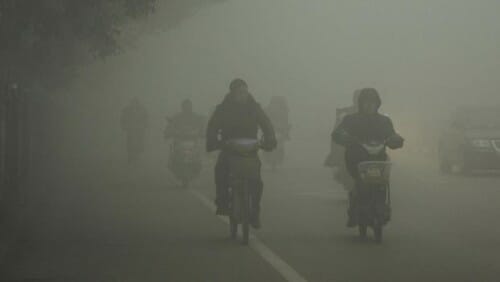Want to Save The Ice in the Arctic?
I wrote below about Chinese pollution, but here is one other thought. Shifting Chinese focus from reducing CO2 with unproven 21st century technology to reducing particulates with 1970s technology would be a great boon for its citizens. But it could well have one other effect:
It might reverse the warming in the Arctic.
The reduction of Arctic ice sheet size in the summer, and the warming of the Arctic over the last several decades, is generally attributed to greenhouse warming. But there are reasons to doubt that Co2 is the whole story. One is that the sea ice extent in Antarctica has actually been growing at the same time the Arctic sea ice cover has been shrinking. Maybe there is another explanation, one that affects only the northern hemisphere and not the southern?
I don't know if you have snow right now or even ever get snow. If you do, find some black dust, like coal dust or dark dirt, and sprinkle it on a patch of snow. Then come back tomorrow. What will you find? The patch of snow you sprinkled in dark dust melted a lot in comparison to the rest of the snow. This is an albedo effect. Snow takes a while to melt because it reflects rather than absorbs solar radiation. Putting black dust on it changes that equation, and suddenly solar radiation is adsorbed as heat, and the now melts. Fast. I know this because I run a sledding hill in the wintertime, where snow falls on a black cinder hill. The snow will last until even the smallest patch of black cinders is exposed. Once exposed, that small hole will grow like a cancer, as it absorbs solar energy and pumps it into the surrounding ground.
By the way, if you have not snow, Accuweather.com did the experiment for you. See here. Very nice pictures that make the story really clear.
So consider this mess:
Eventually that mess blows away. Where does it end up? Well, a lot of it ends up deposited in the Arctic, on top of the sea ice and Greenland ice sheet.
There is a growing hypothesis that this black carbon deposited on the ice from China is causing much of the sea ice to melt faster. And as the ice sheet melts faster, this lowers the albedo of the arctic, and creates warming. In this hypothesis, warming follows from ice melting, rather than vice versa.
How do we test this? Well, the best way would be to go out and actually measure the deposits and calculate the albedo changes from this. My sense is that this work is starting to be done (example), but it has been slow, because everyone who is interested in Arctic ice of late are strong global warming proponents who have incentives not to find an alternative explanation for melting ice.
But here are two quick mental experiments we can do:
- We already mentioned one proof. Wind patterns cause most pollution to remain within the hemisphere (northern or southern) where it was generated. So we would expect black carbon ice melting to be limited to the Arctic and not be seen in the Antarctic. This fits observations
- In the winter, as the sea ice is growing, we would expect new ice would be free of particulate deposits and that any new deposits would be quickly covered in snow. This would mean that we should see ice extents in the winter to be about the same as they were historically, and we would see most of the ice extent reduction in the summer. Again, this is exactly what we see.
This is by no means a proof -- there are other explanations for the same data. But I am convinced we would see at least a partial sea ice recovery in the Arctic if China could get their particulate emissions under control.
Update: Melt ponds in Greenland are black with coal dust
